#organic fertilizer coating
Explore tagged Tumblr posts
Text

Some Factors Affecting the Efficiency of Fertilizer Application
Several factors influence how well plants can utilize the nutrients provided by fertilizers, and understanding these can help farmers and gardeners make more informed decisions. Below, we explore the key factors that affect the efficiency of fertilizer application. There are several sustainable fertilizer treatment solutions available as well.
#sustainable fertilizer treatment solutions#organic fertilizer coating#green technology#efficiency of fertilizer application
2 notes
·
View notes
Text
The important position of coating machine in organic fertilizer production line
1. Improve the quality of organic fertilizer: Organic fertilizer coating machine through the coating treatment of organic fertilizer, can improve the physical and chemical properties of organic fertilizer, make it more suitable for plant growth needs. The coated organic fertilizer is beneficial to plant absorption of nutrients, improve fertilizer utilization, and thus improve crop yield and quality.
2. Extend the fertilizer effect period: After the organic fertilizer coating machine is coated, the organic fertilizer releases nutrients in the soil more slowly and evenly, which is conducive to extending the fertilizer effect period. As a result, crops have a steady supply of nutrients throughout the growing season, which helps to improve yield and quality.
3. Reduce environmental pollution: The utilization rate of organic fertilizer after the organic fertilizer coating machine is high, which reduces the loss of fertilizer and the pollution of soil and groundwater. At the same time, the harmful gases such as ammonia nitrogen generated during the application of coated organic fertilizer are less, which is conducive to reducing greenhouse gas emissions and reducing environmental pressure.
4. Promote the improvement of soil ecology: the organic fertilizer treated by the organic fertilizer coating machine contains rich organic matter and microorganisms, which helps to improve the soil structure, increase the soil porosity, and improve the soil water and fertilizer retention ability.
5. Save resources: organic fertilizer coating machine helps to improve the utilization rate of organic fertilizer, reduce the dependence on chemical fertilizers, and save limited resources. This is of great significance for organic fertilizer production line to achieve agricultural sustainable development.
6. Improve economic benefits: The organic fertilizer treated by the organic fertilizer coating machine has good quality, large market demand, and can bring higher economic benefits.

2 notes
·
View notes
Text
The basic operation points of organic fertilizer equipment coating machine
1. Equipment debugging: Before the formal use, it is necessary to debug and test the coating machine. Ensure that the function of each component is normal, adjust the appropriate working parameters, such as film speed, temperature, etc.
2. Preparation of packaging materials: Prepare suitable packaging materials, usually plastic films or degradable materials that meet food grade and environmental protection standards. Ensure that the packaging material is of good quality and the size is suitable for the equipment requirements.
3. Operation process: Send the prepared organic fertilizer into the feed port of the coating machine. The equipment will wrap the packaging material around the organic fertilizer according to the set parameters. Operators need to monitor the uniformity and tightness of the envelope to ensure consistent quality for each packaging unit. After the envelope is completed, the envelope will be sealed and cut to form a separate bag or roll. Ensure that the seal is firm to prevent leakage or contamination of organic fertilizer.
4. Safe operation: Operators need to pay attention to safe operation procedures to avoid hand contact with mechanical parts or hot surfaces. Keep the working area clean to prevent debris from entering the organic fertilizer equipment and affecting the packaging quality or damaging the equipment.
5. Equipment maintenance: Regular cleaning and maintenance of the coating machine, including cleaning residue, lubricating moving parts, replacing worn parts, etc. Ensure long-term stable operation and production efficiency of equipment.
6. Environmental protection: Pay attention to the waste and waste gas treatment problems generated in the production process of organic fertilizer production line, take appropriate measures to reduce environmental pollution, and meet the requirements of local environmental protection regulations.

0 notes
Text
The important role of organic fertilizer coating machine in the production process
1. Improve the quality of organic fertilizer: Organic fertilizer coating machine by wrapping organic materials in a film, help to protect the microorganisms in organic fertilizer from the external environment, improve the quality of organic fertilizer.
2. Extend the shelf life: In the production process of organic fertilizer production line, it is susceptible to the influence of microorganisms, moisture, oxygen and other factors, resulting in a decline in quality. Organic fertilizer coating machine can effectively block water and oxygen, extend the shelf life of organic fertilizer.
3. Reduce nutrient loss: After the organic fertilizer is coated, the film can effectively fix the nutrients in the fertilizer, reduce the nutrient loss in the fertilization process, and improve the fertilizer utilization rate.
4. Improve soil structure: After the organic fertilizer is coated, it is easy to apply and degrade, which is conducive to improving soil structure and improving soil fertility.
5. Environmental friendly: organic fertilizer coating machine is made of environmentally friendly materials, and does not produce pollution during use. Moreover, the coated organic fertilizer can reduce the amount of fertilizer used and reduce the pollution to the environment.
6. Energy saving: organic fertilizer coating machine in the production process, can achieve automation, intelligent operation, reduce labor costs, improve production efficiency, help save energy.
7. Reduce the risk of diseases and pests: After the organic fertilizer is coated, it can effectively prevent the breeding and spread of diseases and pests, and reduce the risk of diseases and pests. In short, organic fertilizer coating machine plays an important role in the production process of organic fertilizer, helping to improve the quality of organic fertilizer, extend the shelf life, reduce nutrient loss, improve soil structure, achieve environmental friendliness, energy conservation and reduce the risk of pests and diseases.

0 notes
Text
Precautions before operation of the organic fertilizer coating machine
1. Check the equipment: check whether the components of the organic fertilizer coating machine are intact, especially the parts in contact with the material, such as bearings, chains, belts, etc.
2. Lubrication maintenance: According to the requirements of the instruction manual, regular lubrication and maintenance of the organic fertilizer coating machine to ensure the normal operation of the organic fertilizer equipment.
3. Clean up debris: Before operation, clean up debris and residue inside the organic fertilizer coating machine to ensure that the machine is clean inside.
4. Adjust the pressure: according to the production needs, adjust the pressure of the organic fertilizer coating machine to ensure that the fertilizer particles can be evenly wrapped during the coating process.
5. Check the power supply: Check whether the power supply line of the organic fertilizer coating machine is intact to ensure that the power supply is safe and reliable.
6. Trial run: Before the organic fertilizer production line officially runs the organic fertilizer coating machine, first conduct a trial run to check whether the machine is running normally and whether there is abnormal sound or vibration.
7. Precautions: The operator needs to be trained and familiar with the operation methods and precautions of the organic fertilizer coating machine, and illegal operations are strictly prohibited. At the same time, pay attention to safety, wear protective equipment, such as gloves, safety shoes, etc.
In short, the organic fertilizer coating machine needs to carefully check the equipment, clean up debris, adjust the pressure, check the power supply, test run and comply with the operating procedures and other precautions before operation to ensure production safety and product quality.

0 notes
Note
Not a request but imagine Viktor debating whether or not to augment his dick because on one hand fun sexy times and on the other it's his dick shit can go wrong and he doesn't want to affect his fertility if he decides he does want kids
You know, as a fandom, I feel like we don't discuss the dick situation as much as we should... like, I've given my opinion on what's up with the Arcane Herald Penis Predicament (go read more on that in my one-shot The Prophet spoke, and the faithful knelt 👀), but I can't imagine the Machine Herald Cock Conundrum is the exact same...
Here is my hypothesis:
So, Machine Herald replaces the parts of his body that he considers weaknesses or that could be augmented with technology and machinery.
Dick and balls are pretty inconvenient from a technical standpoint, they're an easy target to incapacitate someone in a fight ((fun fact, some animals actually know this and will attack the face or the genitalia of other animals/humans to inflict the most damage)). Plus, they are a strong testament to how much the human body is controlled by emotions and impulses, so it wouldn't be that far-fetched to assume MH!Viktor would have gotten rid of them.
HOWEVER

I believe that this theory would be missing an important aspect of MH!Viktor's philosophy and identity. What he craves is an evolution of the human species through the removal of weaknesses of the flesh, such as illness. And evolution REQUIRES the continued existence of a species through time, which means reproduction is still a key aspect in his vision. It would be counterproductive for him to want to get rid of reproductive organs: they're an essential part of making sure a long-term evolution is even possible.
Additionally, MH!Viktor has been shown through various parts of his lore to be exceptionally caring about children. In that same vein, season 1 Viktor often brings back the concept of having a personal legacy...
Considering both of these factors, I'd say that, yes, MH!Viktor still has his human penis. BUT, he would also definitely get rid of the flaws I mentioned earlier.
For example, he would likely be able to at least partially regulate blood flow to his cock, in order to be in control of his own bodily reactions (ie., when he wants to be hard or not). He would also probably add some sort of protective cover or coating over it, with a flexible but resistant material that would prevent genitalia from being used as a weak spot. Almost like a permanent, metal cocksleeve.
If he was to gain a lover along the way, perhaps the sleeve could be tweaked a little, to add some bonus features. A length enhancer, or some bumpy ridges... the possibilities are truly endless. But it would all be solely for the purpose of his goal, of course, not for something as trivial as pleasure. A lot of research seems to correlate female orgasm to higher chances of pregnancy; he's only doing what has to be done to strengthen the future of the Glorious Evolution. Any additional physical enjoyment is merely a side effect, nothing more.
IN CONCLUSION, according to my professional, scientific opinion, I believe MH!Viktor would keep his human penis, but remove all its conceptual weaknesses with technology. There is simply no version of Viktor in the multiverse that doesn't make use of his big, fat cock, and that's just the way things are 😌.
#I SPENT WAY TOO MUCH TIME THINKING ABOUT THIS AHDJFNNF#viktor arcane#viktor x reader#viktor smut#machine herald viktor#arcane viktor x reader smut#arcane viktor#viktor headcanons#my rambles#my asks#mine#im sooooo normal about him
90 notes
·
View notes
Note
Hi hello I love your Euclidian designs could you explain their anatomy

tysm!! here's some bullshit biology. if i spelled anything wrong. um. i didnt
transcription (since my colors/handwriting are whack) and elaboration below cut hehe
"cellulose microfibril bricks, colored by carotenoid pigment (xanthophyll)" they help maintain the shape of the cell/provide structural integrity to an overall squishy organism. the pigment xanthophyll is yellow (because. bill. yellow) and facilitates photosynthesis yay solar power. the nature of bill's mutation includes a full wall of this shit covering his whole body like a carapace
""brain"/ganglia" very rudimentary nervous system that's just a bundle of nerves hooked up to the eyes. important to note that the nerves are robust and mobile like electrical wires so don't mind being jostled by eye movement
"cilia assist in movement and sensing" leeetle hairs that aren't hairs at all but microtubules coated by the plasma membrane. kinda like whiskers/barbels but used for swimming
"double membrane (two phospholipid bilayers), pseudopods made of actin filaments and filled with cytoplasm" and also "pseudopods are mobile and variable (stretchy) the gripperssssssss if you wanna see some epic pseudopod action just look up amoeba hunting on youtube
"eyelids and "lashes"/teeth" the retractable sheathes that cover the eye have scutes that can flex and poke out as a sorta velcro-y set of teeth and manipulate objects
"mitochondrial pump" i'm sorry to say i didn't actually have an idea of what this organ was when i drew the first drawing don't tell anyone but i make shit up as i go along ummm but now it's the pseudo-heart organelle that generates atp (mitochondria) and circulates shit 'round the body (pump)
"2D eyes can perceive color, brightness, and a single layer/line of depth" so these basically work how the eyes work in flatland where euclideans can only see an infinitely thin plane of color and shadow
"reproductive organs and gametes" my euclideans have external fertilization where a pair (any pair works cuz they all have the same haploid gams) just mush together their gametes to make a baby love wins i didn't really think this through shhh i just cant imagine these things fucking im sorry they're too weird maybe the foreplay goes crazy idk
that's basically it uhm i labeled each shape as "cuboidal", "triangular", and "circular" and then that "circles are (superficially) bilaterally symmetrical" cuz they only got the one eye oh and the circular one is labeled as "juvenile has no compartment for reproductive organs" cuz why not ok bye
#sorry this is a lot of rambling i didn't rlly know what to say so i said. everything😭#ask#art#myart#fanart#gravity falls#gravity falls bill#the book of bill#bill cipher#euclydia#flatland#flatland 2007#tw eyestrain#kinda?
158 notes
·
View notes
Text
Vesuvia Weekly: Guilty Pleasures (poorly doodled)
Julian
Likes his food very, very salty, and in an effort not to be a burden on anyone who cooks for him, carries at least one pouch or shaker of salt around in his coat. It doesn't matter who cooked it or what the dish is, it's the same routine every. Freaking. Time. He takes one bite, exclaims over how delicious it is, pulls out his pouch, shakes at least half a teaspoon over it, and eats the rest with gusto.
You have tried to confiscate it before important dinner events. It's impossible to find and only resulted him suggesting a body search.

Asra
Gets the midnight munchies like clockwork and it's the only thing about them that follows a predictable schedule. It doesn't matter how much or little he's eaten that day or how busy he's been or what he's been up to - the clock chimes twelve, he pauses whatever he is (or isn't) doing, and the stove salamander prepares itself to assist him in crafting some new culinary abomination. You're welcome to join in!
You did try locking all the food in the pantry once to see what they would do. His response was to playfully threaten to eat you instead


Nadia
Has an obsession for things that go "click". The keys on her parlor pipe organ. The little gears and cogs she tinkers with in her free time. The jewels on the hairpieces she wears over her ears. One time you accidentally burned through half her day because she stopped by while you were threading charmed beads, and she was so hypnotized by the cathartic swishes and clicks she missed three meetings.
You did try taking her to a factory with lots of loud clicks in it, only to find out that it was the wrong type of click and she needed to leave

Muriel
Loves squishy things he can sink his hands into so much he's convinced he's not allowed to enjoy them. Thick moss. Large, spongy mushrooms. Soft, dense furs that have just been shaken and fluffed out. It's so hard not to call him catlike on cleaning days, because his response to the furs that have hung in the breeze and sunlight all day is to sit down, sink his palms in, and knead for several minutes.
Once he found a part of your body with enough flesh on it for the soft skin to well up between his fingers, and he fixated on it for a week

Portia
Likes sniffing coffee beans when she needs a pick-me-up. She hates the bitterness of the flavor of it, and she doesn't need the level of caffeine that drinking it would give her, but the smell of freshly ground coffee beans is exactly the afternoon boost she craves. You didn't know about this until you walked in one day, just in time to see her enthusiastically faceplant into a bowl of them with a loud snort.
Nobody knows what she does with the beans after she's ground and sniffed them. You suspect she uses them as garden fertilizer

Lucio
At first you're convinced he doesn't have any guilty pleasures because he simply doesn't feel guilt for a good time in the first place. You are wrong. On the rare occasion that he fully removes his prosthetic, he likes doodling a pair of googly eyes onto what's left of his shoulder and making it "argue" with the hand on his metal arm. They're named "Willy" and "Spikes" and have their own voices.
You walked in on this once when you stopped to have the elbow piece fixed, to Lucio sitting shirtless on the floor debating cookie flavors

#vesuvia weekly#guilty pleasures#ask arcana brainrot#the arcana#the arcana headcanons#the arcana hc#the arcana game#asra the arcana#julian the arcana#nadia the arcana#muriel the arcana#portia the arcana#lucio the arcana#asra alnazar#julian devorak#nadia satrinava#muriel of the kokhuri#portia devorak#lucio morgasson#the arcana fanart
153 notes
·
View notes
Note
If someone, hypothetically, were to paint some miniatures based on the "Holy Dominion of Northwestern Iowa", what colors and kinds of symbology would they potentially use 👀
okay so can I just say that as a lorebrained vexillology dweeb you have given me such a beautiful gift. Ideas that immediately come to mind:
Overarching colors
Red, to represent military valor and The Passion, but never alongside white or blue. The Heptarchate is part of the "post-American" movement within the former United States, rather than one of the polities seeking legitimacy via translatio imperii.
Gold, representing prosperity and ambition; the state's (relatively) bountiful supply of wheat and maize; and the glory of God.
Pale pink or lavender, representing love, temperance, and the Prairie Rose, unofficial flower of the now-defunct United State of Iowa.
Orange, drawn from the founders' (questionable, New-Agey) understanding of Buddhist monasticism. Symbolically, it represents joy; brown, which is essentially a darker shade of orange, may be used to represent trees or fertile soil.
Specific symbols
BROKEN WHEELS. An end to cycles both mundane and metaphysical; a testament to the Palatinate's effectiveness in repelling and pacifying road-warriors.
SUNRISE AND SUNSET. Naturally unifies all the aforementioned colors. Seen as the "successor" to Noah's rainbow - a symbol of God's pledge that the strife of the 22nd century was over, and that humanity would endure.
CROWNS, in particular A CROWNED DOVE, representing the unchallenged authority of God and his earthly representatives, i.e., the Heptarchs themselves. (The Dove is one of the few exceptions to the "don't put white next to red" rule.)
Additionally, families, monasteries, and social organizations - regardless of wealth or social standing - will often have their own crests or coats of arms that contain more unique, personal symbolism.
Such crests will almost invariably include a "Fursona" (untranslatable), an animal meant to represent that group's values and virtues; often, a family's name is derived from its crest rather than vice versa. For example, Lavender's family - the Spadeharts - were so rechristened in the 2130s, being gardeners and farmers who sought to embody the cervine virtues of Meekness, Temperance, Kindness, and Discretion.
61 notes
·
View notes
Text
Round 2 - Mollusca - Polyplacophora
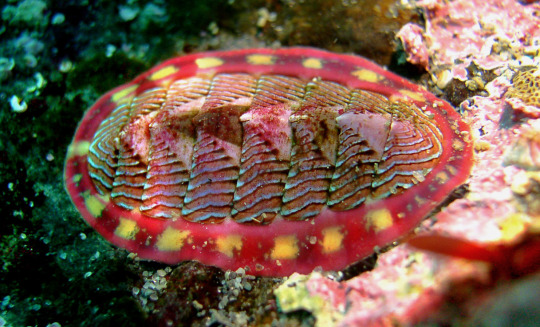
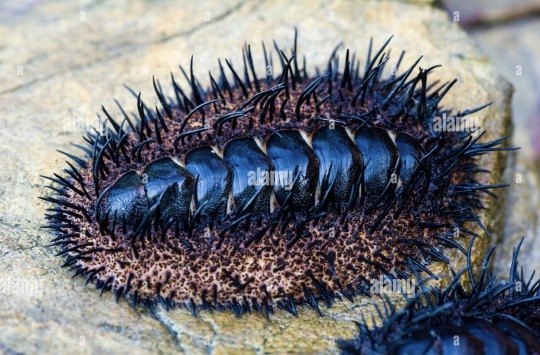


(Sources - 1, 2, 3, 4)
Our first class of molluscs is Polyplacophora, commonly known as “Chitons”, and less commonly known as “Sea Cradles”, “Coat-of-mail Shells”, or “Suck-rocks”.
Chitons have a shell composed of eight separate plates, or valves, which overlap slightly. This allows the chiton to have protection without sacrificing flexibility, as the plates allow for some articulation and even for the animal to curl up into a ball when dislodged from rocks. The plates are circled by a skirt called a girdle, and in some species the tissue of the girdle covers the plates (image 4). Underneath the shell, the majority of the body is a muscular, snail-like foot. Gills hang down into the mantle cavity on either side of the foot. The mouth is also located on the underside of the animal and it contains a mouth with a tongue-like, tooth-covered structure called a radula. The radula is used to scrape food from rocks. Chitons have unique organs called aesthetes, which consist of light-sensitive cells just below the surface of the shell. Some species have modified aesthetes which form ocelli. These ocelli are actually quite advanced, with a cluster of individual photoreceptor cells lying beneath a small aragonite lens. Each lens can form clear images. An individual chiton may have thousands of ocelli on their back. Chitons live worldwide, exclusively in marine waters, clinging to hard surfaces. Most species live high in the intertidal zone, exposed to air and light for long periods. A few species live in deep water, up to as 6,000 m (20,000 ft) down. They are generally herbivorous grazers, though some are omnivorous and some carnivorous. They eat algae, bryozoans, diatoms, barnacles, and sometimes bacteria by scraping the rocky substrate with their radula. A few species of chitons are predatory, catching small invertebrates, such as shrimp and possibly even small fish, by holding an enlarged, hood-like front end of their girdle up off the surface, and then clamping down on unsuspecting, shelter-seeking prey (image 3).
Chitons have separate sexes, and usually reproduce externally, with males releasing sperm into the water to find the female’s released eggs. In some species, fertilization takes place in the mantle cavity, with the female then brooding the eggs within the mantle cavity. The species Callistochiton viviparus gives birth to live young. Chiton eggs have a tough spiny coat, and usually hatch to release a free-swimming trochophore larva. In some species the trochophore remains within the egg, deriving nutrition from yolk, then hatching as a miniature adult. Unlike fully grown adults, larvae have a pair of simple eyes, and these may remain for some time in the immature adult.
Chitons have a relatively good fossil record, dating back to the Cambrian. The genus Preacanthochiton is often classified as the earliest known polyplacophoran, though this is controversial and some authors have instead argued that the earliest confirmed polyplacophorans date back to the Early Ordovician. Kimberella and Wiwaxia of the Precambrian and Cambrian may be related to ancestral polyplacophorans.

Propaganda under the cut:
There is a good fossil record of chitons, but ocelli are only present in those dating to 10 million years ago or younger. This could mean chiton ocelli are the most recent eyes to evolve.
Some species of chiton exhibit homing behavior, journeying to feed and then returning to the exact spot they previously inhabited. It is yet unknown how they do this. They may have topographic memory of the region, or they may be picking up on chemical clues from their slime trail. Their teeth are made of magnetite, and they may be able to sense the Earth’s magnetic field through them, as experimental work has suggested that chitons can detect and respond to magnetism.
Chitons are eaten in many oceanic cultures, including in Trinidad, Tobago, The Bahamas, St. Maarten, Aruba, Bonaire, Anguilla, Barbados, Bermuda, the Philippines (where they are called kibet if raw and chiton if fried), along the Pacific coast of South America, the Galápagos, South Korean islands, by First Nations people off the Pacific coast of North America, and by Aboriginal Australians.
When a chiton dies, its girdle will rot or be scavenged away, and the eight plates will come apart. These plates sometimes wash ashore and are known as “butterfly shells.”
Some chitons bear scales or needle-like spicules on their girdles which can be used for camouflage or defense:
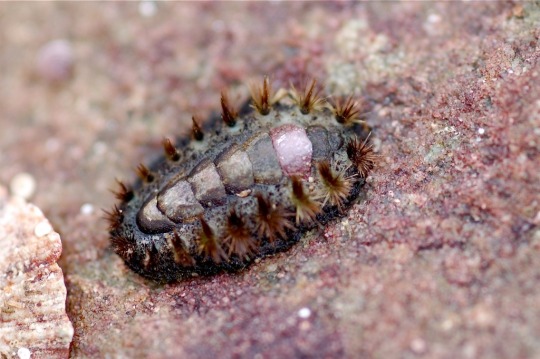
(source)
76 notes
·
View notes
Text

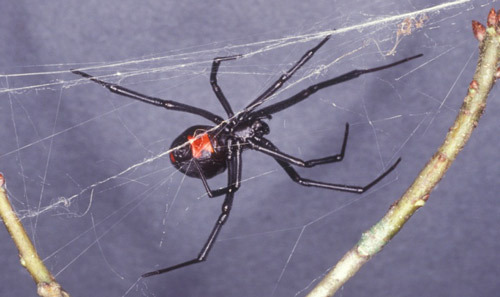
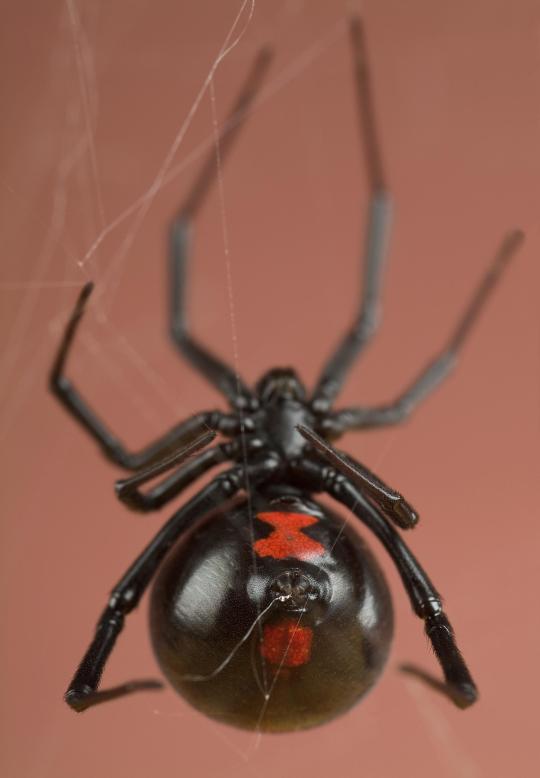
No Tears for the Southern Black Widow
Latrodectus mactans, more commonly known as the southern black widow, is the most common species in the black widow family. While it can be found throughout North America, they are found most often in the southern United States. Within this wide range, L. mactans enjoys a variety of habitats. They prefer areas that are close to the ground, dark, and sheltered; in the wild this may mean dense brush or under logs, while in inhabited areas they may be found in basements, log piles, or under trash lids.
In addition to being the most common black widow, L. mactans is also the largest member of the family Theridiidae. The females are larger than the males, averaging at about 8-10 mm (0.31- 0.39 in) in length and weighing about 1 g (0.04 oz); however the male's legs are generally longer than the females. Both males and females are black, with small thoraxes and extremely large, round abdomens. The female can be distinguished by the iconic red hour-glass shape on the underside of her abdomen, while the male has 4 pairs of red and white stripes on each side of his abdomen.
The southern black widow is mainly solitary, spending most of its time in or near its web. Only the females live long enough to build a web for catching prey, and are the sole source of black widow bites. While bites do require medical attention, no human fatalities have been reported since 1983.
During the day, females hang in the center of the web to expose the bright red warning on their abdomen; when startled they drop to the ground and play dead. Though the webs they construct are haphazard-- the stereotype of cobwebs-- they are extremely strong and are capable of catching woodlice, millipedes, centipedes, other spiders, and occasionally small mice. Once an animal becomes trapped in L. mactan's web, the spider envenoms its prey and wraps it in a thick cocoon. After the animal dies the spider injects it with digestive enzymes and consumes the resulting fluid. Despite their strong venom, the southern black widow can be victim to several predaotrs; namely wasps, the brown widow spider, praying mantises, and large centipedes.
The southern black widow mates primarily in the spring and summer. Mature males build small webs and deposit semen along the threads. He then coats his mouthpieces-- palps-- with sperm and sets out to find a female mate. To court her, he vibrates the threads of her web until she is receptive. On rare occasions, a displeased female may eat the male. Afterwards, if he survives, the male leaves the females web and dies soon afterwards. From just one encounter, the female can store enough sperm to last her a lifetime of reproductive cycles.
After fertilization, the female builds a small web where she lays her egg sac, which can contain up to 400 eggs. She guards these eggs until they hatch about 20 days later, and immedietly disperse to establish their own territories. Until they become fully mature, at about 90 days old, juveniles have no venom and are extremely vulnerable to predators- including adult black widows. Typically only about 30 individuals from a single clutch survive to adulthood. Once mature, males can live for only one year, while females can live up to three years in the wild.
Conservation status: The IUCN has not evaluated the southern black widow, but due to its large range and population size it is considered stable. It is able to adapt to most habitats, and thus the species' only threat comes from extermination via pest control.
If you send me proof that you’ve made a donation to UNRWA or another organization benefiting Palestinians, I’ll make art of any animal of your choosing.
Photos
Mark Kostich
James L. Castner
Meghan F. Murphy
#southern black widow#Araneae#Theridiidae#black widows#true widows#tangle-web spiders#cobweb spiders#spiders#arachnids#arthropods#generalist fauna#generalist arthropods#urban fauna#urban arthropods#north america#southern north america
182 notes
·
View notes
Text


Get Coloring Agents from NAQ Global
NAQ Global offers you amazing coloring agents for your fertilizer at the best price. Coloring agents make the fertilizer more presentable and appealing. We provide various coloring agents for fertilizers according to customer suitability. Visit our website to know more about our coloring agents.
Visit now: https://www.naqglobal.com/product/coloring-agents
#organic fertilizer coating#fertilizer#coloringfertilizer#coloring agents for fertilizer#coloring agents#fertilizers coloring agents
0 notes
Text
Organic fertilizer equipment coating machine: Shaping a new chapter of fertilizer efficiency
In the field of organic fertilizer production, the coating machine(http://www.tiancimachine.com/fertilizer-dryer-cooler-coating/coating-machine.html) has become an indispensable and important organic fertilizer equipment(https://www.tiancimachine.com/products/). With its unique advantages, it has injected new vitality into the production process of organic fertilizer, and played an important role in improving the quality of fertilizer, improving the production efficiency of organic fertilizer production lines(https://www.tiancimachine.com/production-line/), and reducing costs.
The main function of the coating machine is to wrap a protective film on the fertilizer particles to extend the fertilizer effect period and improve the utilization rate. During the production process, the coating machine precisely controls the thickness and uniformity of the coating through the fine screening, metering and mixing of the particles, thus ensuring the best results of the fertilizer. In addition, the coating machine can also effectively reduce the contact between fertilizer and air, prevent oxidation deterioration, and improve the storage period.
Compared with traditional manual or simple equipment, the coating machine has significant advantages. First, it can greatly improve production efficiency and reduce labor and time costs. Secondly, the coating machine has higher accuracy and stability, which can ensure the quality and uniformity of the fertilizer. Finally, the coating machine has a high degree of automation, easy operation, and reduces the error rate in the production process.
In addition, the environmental performance of the coating machine can not be ignored. It can reduce the contact between fertilizer and the air, reduce pollution emissions, and is friendly to the environment. At the same time, by precisely controlling the thickness and uniformity of the coating, the utilization rate of fertilizer is effectively improved and the production cost is reduced.

0 notes
Text
Organic fertilizer coating machine needs to be regularly maintained
With the continuous advancement of agricultural modernization, the application of organic fertilizer coating machine in agricultural production is increasingly extensive. As a new type of fertilizer production equipment, organic fertilizer coating machine can not only improve the utilization rate of fertilizer, but also effectively protect the environment and reduce agricultural non-point source pollution. However, in order to ensure the normal operation of the organic fertilizer coating machine and extend its service life, we need to carry out regular maintenance and maintenance of the organic fertilizer coating machine.
1. Check and adjust the working parameters of the organic fertilizer equipment to ensure that the equipment is running in the best state.
2. Check and replace worn parts, such as bearings and seals, to ensure the normal operation of the equipment.
3. Clean the equipment to remove residual fertilizers and contaminants and keep the equipment clean and hygienic.
4. Check and adjust the electrical system of the device to ensure the normal power supply and operation of the device.
Regular maintenance of self-cultivation precautions
1. Regular maintenance should be carried out after the equipment stops running to ensure the safety of the operator.
2. Professional tools and equipment should be used during maintenance to avoid damage to the equipment.
3. During the maintenance process, the operating procedures should be strictly observed to ensure the correctness and safety of the operation.
Organic fertilizer coating machine as an important equipment in agricultural modernization, its performance and life are closely related to regular maintenance. Only through regular maintenance can we ensure the normal operation of organic fertilizer production lines and extend their service life, so as to improve the economic and environmental benefits of agricultural production.

0 notes
Text
I must make an apology. Last Wet Beast Wednesday I declared that I was balancing out the vertebrate/invertebrate balance of this series. However, I realized that all the invertebrates I've covered have been arthropods. This is a grave misrepresentation of invertebrate diversity and I must make amends. Thus, this week we're returning to the no bone zone and talking about siphonophores.

(Image: a collage of different siphonophore species, sourced from Wikipedia)
Siphonophores are cnidarians: soft-bodies, radially symmetrical organisms that also include jellyfish, anemones, and corals. They are definitely amongst the weirdest of cnidarians. Most of them look like either a jellyfish or an anemone, but siphonophores run a whole gamut of shapes: from the jellyfish-like Portugese man-o-war to the vaguely comb jelly-like Praya dubia, to whatever the heck this thing is

It looks like a bunch of glass vases on a stick (image: Marrus orthocanna)
Their appearance is the least weird thing abut them. Siphonophores are colonial organisms. Each individual animal is composed of multiple smaller organisms called zooids. All zooids share the same DNA, but are specialized to perform different functions as determined by their morphology. Because each type of zooid is specialized to perform a single function, they are dependent on each other to survive and cannot exist alone. Cnidarians exist in two forms, which many will switch between during their life cycle: sessile polyps and mobile medusas. Siphonophores do this differently, with each zooid type being either a medusa of a polyp. Biologists have described multiple types of zooids found across many species of siphonophore. These include nectophores (used for propulsion), gastrozooids (used for digestion), palpons (used to regulate gastrovascular fluids), gonophores (used in reproduction), and pneumatophores (gas-filled floats only found in some species).

(image: a diagram of different zooid types. Source)
There are 175 known species of siphonophore. The majority of species are pelagic, remaining in open water their entires lives, though a few reside on the sea floor. While they do have some ability to direct their movements, like jellyfish, they are often pulled along by currents. The majority of species live in the deep sea and deep-sea species are often larger than shallow-sea species. Like their jellyfish and anemone relatives, siphonophores are predators who use tentacles to capture prey. Each tentacle is covered with stinging cells called nematocysts that fire venom-coated barbs into organisms that touch them. The prey is then pulled into gastrozooids and digested. Most species are capable of bioluminescence, which is likely used for defense. Some species also develop bioluminescent lures used to attract prey. Some siphonophore can get extremely large, with the species Praya dubia reaching u to 50 meters (160 ft), making it longer than a blue whale and possibly the longest animal in the world depending on how you measure the bootlace worm.

(image: a Praya dubia catching fish)
Siphonophores reproduce with varying methods, some of which are poorly-understood. A new colony usually begins form a single fertilized egg. This egg hatched into a single protozooid that then produces other zooids via budding. In many species, the protozooid will form a central stalk from which groups of other zooids will bud. Other species use polyps that can be ejected into the water carrying eggs and sperm which they use to fertilize themselves. In any case, special zooids called gonophores are used to make the gametes. Different species are either dioecious (each colony has either male or female gonophores) or monoecious (each colony contains both male and female gonophores.

(Image: a diagram of a siphonophore life cycle. Source)
Cnidarians are believed to have existed since the precambrian, though as soft-bodied animals fossilize more rarely, the exact origin of siphonophores is not known. Some scientists speculate that the colonial nature of siphonophores may represent an early stage in the development of true organ systems. If this is correct, the development would go something along the lines of colonies of single-celled organisms -> colonies of single-celled organisms with differentiated functions -> siphonophore-like colonial organisms -> individual organisms with differentiated organ systems.
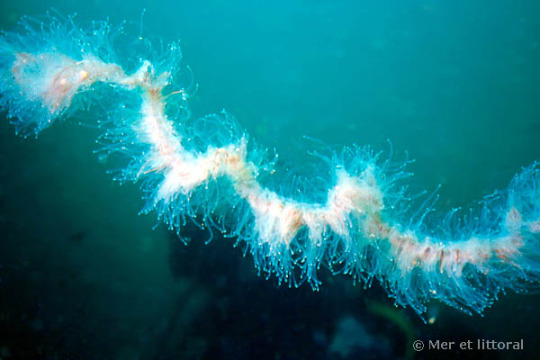
This one's called a "long, stringy, stingy thingy". No really, look it up (image: Apolemia uvaria)
The most famous siphonophore and the first one described is Physalia physalis, the Portugese man-o-war or bluebottle. It is a neuston, an organism that lives at the boundary between water and air. Its most notable feature is the enlarged float filled with carbon monoxide that keeps it floating at the surface of the water. The float functions as a sail, letting it travel thousands of miles. Stinging tentacles trail below it to collect prey. The sting of a bluebottle is very painful to humans and can even be lethal in rare circumstances. Many a beach trip has been ruined by a man-o-war sting. Its morphology and development is different enough from other siphonophores that I may dedicate a whole post to it in the future.

(image: a Portugese man-o-war)
#wet beast wednesday#marine biology#biology#zoology#ecology#animals#invertebrate#cnidarians#siphonophore#animal facts
457 notes
·
View notes
Text
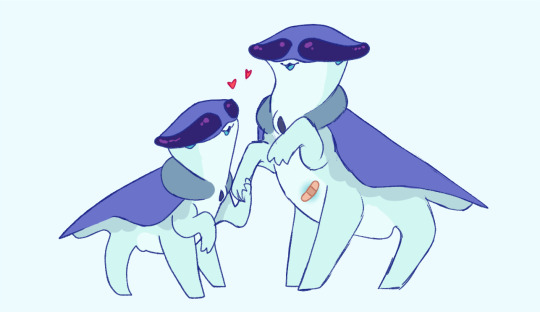
Whorls Reproduction Explanation Post! And most kinds of pentapods, think of it as like a base line. Nothing graphic below the cut, unless organ diagrams are graphic!
The first thing to note is the SETTUP!

You can kind of cut up the area of the body housing the reproductive system into three parts. The first is the spine/core of the pentapod which both cradles the vital organs, anchors the limbs, and allows for the anchoring of the reproductive organs as well! Anchored to the core is the musculature involved with the usage of the spearing portion of their anatomy. And then the vast majority of the actual organs are surrounded by a thick coat of fat and connective tissue, mostly to stop spearing damage to internal structures. But this is also where excess fat will be stored, there and around the neck but that's a whole other post. Lets get more in detail about the exact organs going on!

The Spear - This is the part dedicated to stabbing into their partner for insemination. It's made of the same material as their shells but may also be reinforced with copper during their younger years.
Palpal Bulb/Prostate/Fluid Sack?- Not sure for the name on this one yet but it functions as where the fluid housing sperm is made, but with a bonus. This also is a cocktail of various hormones to induce ovulation of their partner as well as reduce the immune response.
Vas Deferens- The tubes to move the sperm up from the testes, they're just placed on the outside rather than in. Slight design flaw there.
Testes- You know what these are.
Ovaries- These too.
Spermatheca- These are where sperm is stored after it is pulled from the blood stream, all the bloodflow from the fat runs through here. It is also where eggs will be released into to allow fertilization, most Whorls will have their children in sets of 8ish because of the settup there.
Tough Fat- The fat here protects the gonads, so it is a lot firmer than in other places. Honestly it's mostly sinew. With the texture of like.. those big novelty pencil erasers.
Soft Fat- The name is a little misleading because this fat still has the consistency of rubber! It is pierced easily but seals back up quickly, stopping much bloodloss.
The Womb- Whorls are ovoviviparous, so while the babies hatch from their eggs within the mother, there is no other nutrient exchange going on there. Once they hatch they are soon after birthed to begin their aquatic larval stage.
The Birth Canal- Where babies come out! And exit only! Whorls have a one direction reproductive tract.
Now the optimum stabbing strats.

Not all stab wounds are created equal in the world of Hypodermic Insemination, a Whorls anatomy is built to favor some spots over others when it comes to mating. The most 'fertile' places to stab into are going to be the fat surrounding the baby making bits. Here the sperm is most easily acquired from the bloodstream. Nearby is the next best place as the blood can still carry it over. Pink areas may work rarely but the immune system is generally too fast in getting at the foreign material for it to get where it needs to go intact. Trying to stab the shell will result in just a awkward situation.
That's the main physical side of things! Other important things to note is that while Whorls can take on either role once they reach sexual maturity, they generally don't start being impregnated until later on in life. There are societal implications surrounding the stabber and stabbee, but typically the older or more dominate partner is expected to take on the duty of pregnancy.
Also important to note is that gender for Whorls is more closely akin to marital/familial status. Children/teens are not divided up at all, but once hitting adulthood Whorls will progress through several different genders and their roles within their lifetime. This is the way rough of the idea.
None- Prepubescent individuals still with their birth family.
Preened- Those who physically can breed but socially don't, and have also left their birth family.
Courting- Looking for a marriage/family to either start or join.
Tender- Has married into a family and is helping to raise children. But does not actively help make the children.
Piercer- Those who actively impregnate.
Vessel- The one who becomes preggo.
Dull- No longer breeding but have in the past.
But this is just the rough idea and not everyone follows the same path in life! Some may never be pregnant themselves, but father children or vice versa. Some may never breed at all to focus on their spouses other children. Some live solo lives! Varied experiences out here. That's all I gotta say about that for now though.
#whorls#pentapods#spec bio#speculative biology#speculative anatomy#yay this was fun#i love organ explainations#aliens#art#worldbuilding#anatomy
271 notes
·
View notes